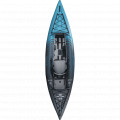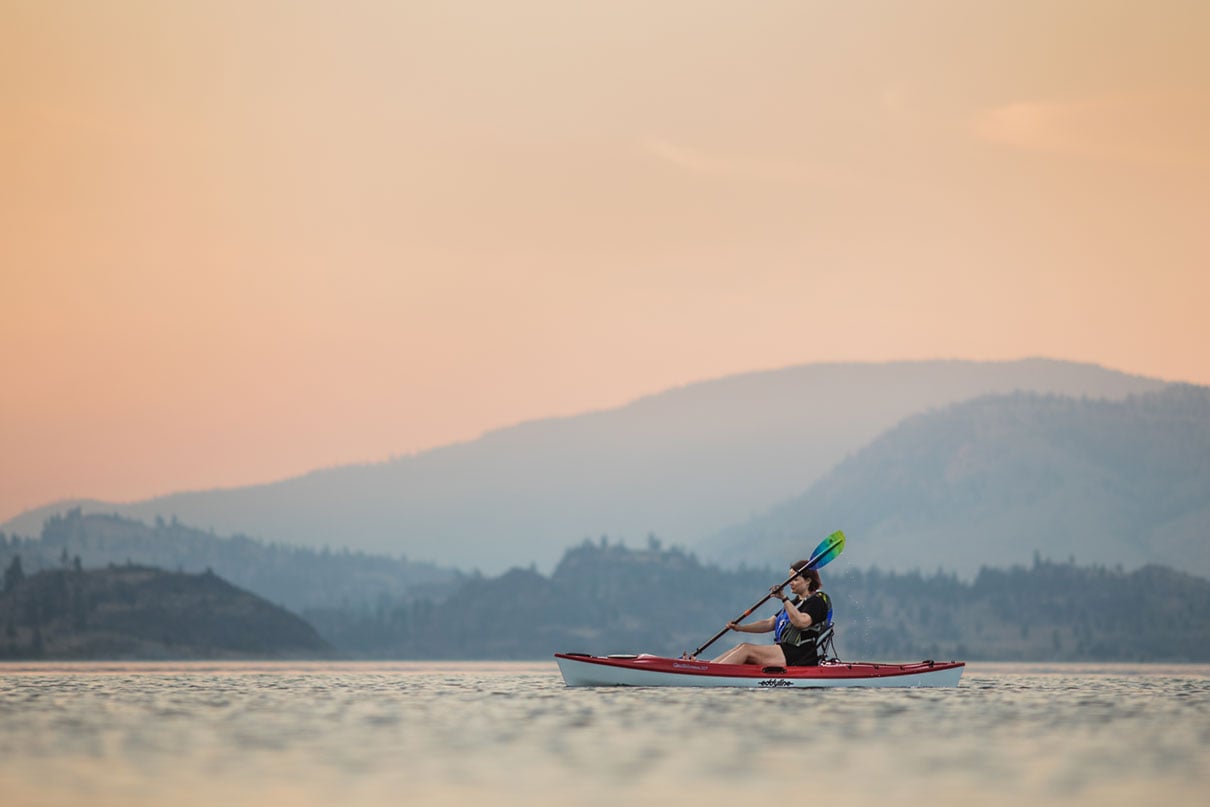Everyone wants a lightweight kayak. The main questions are, can you afford to buy a lightweight kayak? And do you really need one? Weight is a big deal in kayaks. For starters, the best lightweight kayaks are highly portable and easy to move around for people of all sizes and fitness levels. Lightweight kayaks can be carried longer distances to access more remote bodies of water.
Secondly, lightweight kayaks tend to be more efficient: they’re highly responsive to paddle strokes and glide farther in the water than a comparable heavy kayak. The construction of lightweight kayaks (generally composites like fiberglass, Kevlar and carbon fiber, as well as thermoform ABS plastic and wood-epoxy) make them sleeker and more efficient at cutting through the water. However, lightweight kayaks often come at a premium price.
The exception to the price caveat are inflatable kayaks, which tend to be lighter than comparable rigid hull recreational kayaks. However, inflatable kayaks lack the paddling efficiency of a hardshell kayak, and therefore miss out on one of the greatest benefits of a lightweight composite kayak.
Is a lightweight kayak for you? Consider where you’ll be paddling and how important it is to have the most portable kayak possible. Are you looking for responsiveness, speed and efficiency (all hallmarks of lightweight kayaks)? Finally (and perhaps, most importantly) consider your budget, recognizing that lightweight kayaks come with higher prices.
This article will help you buy the best lightweight kayak for your paddling needs.
Top picks: Best lightweight kayaks for 2025
The following lightweight kayaks have received the highest star ratings by reviewers in our Paddling Buyer’s Guide.
Best Lightweight Kayaks

Rewind MD River Play Whitewater Kayak

AirFusion EVO

Chelan 120
Shopping for a used lightweight kayak?
Buying used can be a good way to save some money on a lightweight kayak. You’ll find plenty of used kayaks listed on buy-and-sell websites like Craigslist, Kijiji and Facebook Marketplace. If you’re patient, you may also score a great deal on a used rental lightweight kayak from an outfitter at the end of the paddling season.
Regardless of where you uncover a gem, your first step in making a good investment is to research the specific attributes of the used kayak you are considering.
Once you decide you’ve discovered a true contender, consider the following advice to make a good used lightweight kayak purchase:
- Do your research: Buy the right used kayak for your paddling preferences by researching the particular model in advance to determine whether or not it truly meets your needs.
- Give the used lightweight kayak a once-over, looking for damage to the hull (bottom), deck (top) and outfitting (seat, back rest, foot pegs, etc). The best lightweight kayaks are meant to be light, not necessarily durable, so take a close look at wear areas along the bottom of the kayak—paying close attention to areas where the glossy outer layer has been worn away or cracked. This sort of detailed inspection is important for composite (fiberglass, Kevlar and carbon fiber) and thermoform ABS kayaks.
- Try to determine how the kayak was stored. A kayak that was stored outdoors for long periods of time may be subject to fading due to UV radiation (which also weakens the kayak’s structure) and damage due to excessive snow loading or precipitation. Many ultralight composite kayaks do not have gelcoat pigment, and such “clearcoat” hulls are more subject to UV degradation.
- Taking the kayak for a test paddle is the best way to find out whether the kayak works for you in terms of performance, handling, comfort and fit.
For more tips on what to look for when selecting a used lightweight kayak, read our article How To Buy A Used Kayak.
Lightweight kayak buying guide
Before you commit to purchasing a lightweight kayak, consider your exact needs in a kayak. Are you looking for a kayak that’s easy to lift on and off your car and carry, even for longer distances to remote bodies of water? Are you concerned about your strength and ability to carry a kayak? Are you looking for the most efficient kayak? Do you have a substantial budget? All these points should lead you to choosing a lightweight kayak.
Lightweight kayaks are available in all genres of kayak, from whitewater to touring (sea) kayaks, as well as recreational and fishing kayaks. In general, it’s the construction style that sets lightweight kayaks apart from the rest. Lightweight kayaks come in four different types of construction:
- Composite construction includes fiberglass, Kevlar (aramid) and carbon fiber (as well as space-age combinations of all of the above). These kayaks are light and reasonably durable, with a wear-, scratch- and UV-resistant outer gelcoat (or clearcoat) layer. Composite kayaks are stiff and rigid and cut efficiently through the water. Carbon fiber and Kevlar are the two most expensive materials used in kayak construction. Composites are most frequently used for touring (sea) kayaks and fitness kayaks.
- Thermoform ABS is a heat-molded plastic that’s lighter and stiffer than rotomolded polyethylene (another common plastic used in all types of kayak). Thermoform kayaks are distinguishable by their shiny finish and two-tone colors. They’re tough, but not quite as resilient to impact as rotomolded polyethylene. Thermoform ABS kayaks are priced between composite and rotomolded polyethylene. Day touring, sea, recreational and fishing kayaks are all available in thermoform construction.
- Wood kayaks are available in the form of kits, which appeal to woodworkers. Wood kayaks are essentially sandwiches of lightweight wood (often cedar or marine-grade plywood) between inner and outer layers of composite fibers (fiberglass, Kevlar or carbon fiber). Some models replace the inner layer of composite fiber for a weight-saving epoxy. Wood kayaks are sleek, strong and aesthetically pleasing, and offer crafty people with access to shop space and tools a cheaper pathway to a lightweight kayak. Kits catering to recreational and touring kayakers are available.
- Inflatable and folding kayaks are good options if you’re looking for a supremely portable, easy to store lightweight kayak. Inflatable kayaks are usually cheap and light. However, their flexible hulls contribute to a sluggishness in the water. Folding kayaks like those made by Oru Kayaks are more expensive, but offer better performance and are light enough to carry like a backpack.
Here are some common questions from those looking to buy a lightweight kayak.
-
What is a lightweight kayak?
A lightweight kayak is a kayak that’s easier to carry and load on and off your car than a typical kayak. Lightweight kayaks are usually made of high-tech materials like fiberglass, Kevlar and carbon fiber, as well as thermoformed plastic. They are sleek and more efficient at cutting through the water. Lightweight kayaks are also usually more expensive.
-
How heavy is a lightweight kayak?
A lightweight kayak can be roughly defined as a kayak that’s under 35 pounds for a recreational kayak or under 45 pounds for a touring kayak. A typical recreational kayak weighs 40 pounds or more while a touring kayak is usually well over 50 pounds. Lightweight kayaks are easier to carry and lift on and off your car, as well as being more responsive and efficient to paddle.
-
Is a lighter kayak better?
A lighter kayak is better if you’re looking for a boat that’s easy to lift and carry. Those seeking the fastest, most efficient kayak will also prioritize boats that are lightweight. However, lightweight kayaks tend to be more expensive—something to consider if you’re only planning to paddle casually and don’t need the fanciest kayak.
Lightweight kayak reviews
Read our expert reviews of a range of lightweight kayaks to help you narrow your search for the perfect boat.
- Inflatable Kayak Review: AIRE’s Spud & Tater
- First Look: Eddyline Caribbean 10 Recreational Kayak
- Fishing Kayak Review: Pelican Mustang 100x
- Hybrid SUP Kayak Review: Hobie Mirage Lynx
- Folding Kayak Review: Oru Inlet
- Folding Kayak Review: TRAK 2.0 Touring Kayak
- Lightweight Touring Kayak Review: Hurricane Kayaks Sojourn 135
- Lightweight Touring Kayak Review: Stellar Kayaks S14-LV
- Lightweight Touring Kayak Review: Delta Kayaks 12S
- Lightweight Touring Kayak Review: Swift Saranac 14









